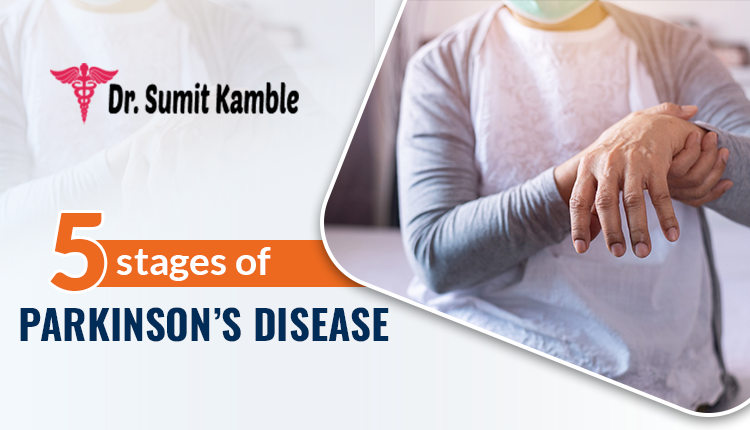What are the 5 stages of Parkinson’s Disease?

The identifiable symptoms of Parkinson’s disease 5 stage, such as tremors, stiffness, and shaking, are typically the first things that spring to mind when most people think about the condition. However, not everyone with Parkinson’s disease has the same symptoms or experiences them similarly. Parkinson’s disease is a degenerative ailment that affects the neurological system, and the symptoms of the disease become more severe over time.
What is Parkinson’s disease?
Parkinson’s disease 5 stage is a progressive neurological condition that can have a wide range of effects on the body. This condition is referred to as a “movement disorder” because it alters how your brain can freely regulate different portions of your body. The existence and advancement of specific recognized symptoms, such as an involuntary tremor and alterations in speech and gait, are often diagnostic of this type of chronic illness, typically distinguished by the presence of these symptoms. Parkinson’s disease is a degenerative ailment that affects the neurological system, and the symptoms of the disease become more severe over time.
What are the 5 stages of Parkinson’s disease?
It is challenging to provide an accurate prognosis on the rate at which Parkinson’s disease 5 stage will advance. There are a lot of different aspects that come into play, one of which is the standard of the medical treatment that an individual receives. Some people can shift from Stage 1 to Stage 2 in a matter of months, whilst for others, it may take several years before they can do so. Someone can progress from Stage 1 to Stage 5 over several decades.
The following are the 5 stages of Parkinson’s disease:
1. Changes in a Person’s Habits:-
At this early stage, a person’s family and friends may be the first to detect changes in how the individual moves, recognize poor posture and see alterations in facial expressions. At this stage, they are typically not severe enough to interfere with everyday activities or the quality of life in general. Hallmark symptoms of stage 1 Parkinson’s disease are characterized by tremors and other movement problems, mostly confined to a single side of the body. Fortunately, there are drugs available by prescription that have the potential to help reduce the severity of these kinds of symptoms in the early stages.
2. Muscle Stiffness and Posture Problems:-
Trembling, stiffness, and other obvious physical symptoms are some examples. At this stage, the disease can affect both sides of the body (although it is typically worse on one side), and it is also capable of causing difficulties with one’s ability to communicate verbally. Although stage 2 of Parkinson’s disease does not typically create problems with balance, other movement symptoms, such as muscle rigidity, might make it more challenging to complete tasks. A person’s posture may become impaired due to the ailment at this stage, resulting in discomfort in the back and neck.
3. Poor Reflexes and Balance Issues
In some cases, stage 3 might also bring about slower reflexes and an overall lack of balance. Because of this, persons in stage three of the disease exhibit mobility problems that are more obvious or appear to slow down.’ Unluckily, during this point, balance and reflex difficulties can cause falls to occur more frequently, which can be pretty dangerous.
In this stage, many of the symptoms in stage 2 are still present, and day-to-day tasks like getting dressed, eating, and getting out of bed become increasingly difficult. It is essential to emphasize that persons diagnosed with stage 3 can still lead independent lives.
4. Poor Motor Skills
At stage 4, a person’s motor abilities are severely impaired; as a result, movement symptoms negatively impact their capacity to maintain their independence. There will undoubtedly be instances in which people decide to live alone at this point, yet, the fact is that performing even the most basic of duties can become incredibly challenging and even hazardous.
In addition, up to fifty percent of people with Parkinson’s disease who are in the final two stages report experiencing confusion, hallucinations, and delusions.
5. Severe Stiffness
The final and most debilitating stage of Parkinson’s disease, stage 5 also reflects the disease’s most advanced progression and is the point at which symptoms become noticeable. When someone is stiff, standing or walking can be extremely challenging, if not impossible altogether.
Assistance is required at all hours of the day and night, and many of the patients must either use wheelchairs or remain bedridden. When the patient tries to stand, the rigidity in their legs causes them to freeze effectively. This is because of the patient’s condition. Because of these symptoms, carrying out normal daily activities without assistance is impossible and highly hazardous.
Conclusion:-
To begin, those who have been diagnosed with Parkinson’s disease must seek medical attention as soon as they can. The sooner they receive a diagnosis, the sooner they can start the necessary treatment. If you are facing severe Parkinson’s disease, then you should consult the Best Neurologist In Jaipur. Dr. Sumit Kamble is the most reputed neurology doctor in Jaipur and has years of work experience and is the best neurologist in Jaipur for Parkinson’s disease treatment and also for treating ailments such as brain stroke treatment, Headache treatment, Epilepsy, and spine difficulties.

 Previous Post
Previous Post Next Post
Next Post